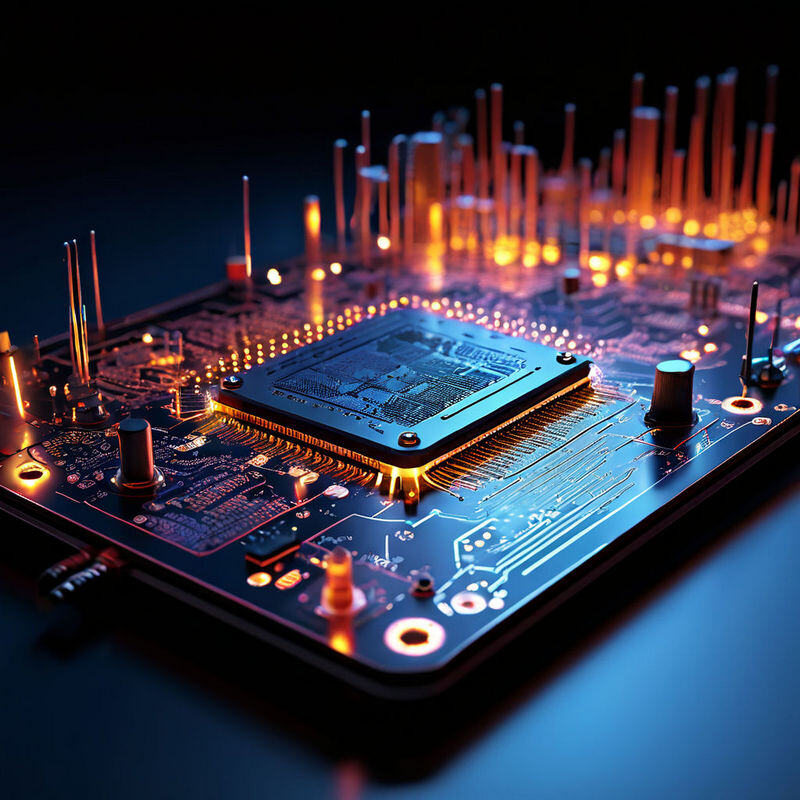Patents, PCBs, Drones and Robots

Innovators from around the world submitted 3.46 million patent applications in 2022, marking a third consecutive year of growth, according to WIPO’s annual World Intellectual Property Indicators (WIPI) report.
In the fiscal year of 2023, a total number of 346,152 patents were granted at the U.S. Patent and Trademark Office. This is an increase from the fiscal year of 2000, when 182,218 patents were issued.
While complete data availability is delayed between application and publication we know that recent data from 2021 shows where the highest number of patents occur:
- Computer technology emerged as the most frequently featured technology in published patent applications worldwide, accounting for 1% of the world total.
- It was followed by electrical machinery (6.4%)
- Measurement (5.8%)
- Medical technology (5.2%)
- Digital communication (4.9%)
Among the top 15 fields of technology the three fields to have witnessed double-digit growth between 2011 and 2021:
- Chemical engineering (+11.4%)
- Computer technology (+11%)
- IT methods for management (+13.7%)
A moment in history…
 Benjamin Franklin was an avid inventor, but he never patented any of his inventions. His reasoning is stated in his autobiography:
Benjamin Franklin was an avid inventor, but he never patented any of his inventions. His reasoning is stated in his autobiography:
“That, as we enjoy great advantages from the inventions of others, we should be glad of an opportunity to serve others by any invention of ours; and this we should do freely and generously.”
Benjamin Franklin
A few of Ben Franklin’s inventions include:
- Swimming fins. Franklin loved swimming.
- The Franklin stove.
- Lightning rod.
- Streetlamps.
- Bifocals.
- Odometer.
- Flexible urinary catheter.
- Glass harmonica.(video story below)
In 1903, German inventor Albert Hanson filed the first patent for a PCB-like device for use in telephone systems. The device was a flat conductor for a multi-layer insulating board. The board had through-hole construction and conductors on both sides, just like plated through-hole PCBs today.
In 1936, Austrian inventor Paul Eisler created the first functional printed circuit board (PCB) to operate a radio system. Eisler's design was intended to reduce the amount of manual labor required to solder wires by hand. The first PCBs used "through-hole construction," which involved drilling holes into the board for each component's wire. Early PCB materials included wood, Bakelite, and Masonite.
AND NOW
Since 1761, when the glass harmonica was invented, to 2023 with hundreds of thousands of patent applications are submitted each year… an invisible change is happening. New uses for PCBs are yet to be discovered. Each has their unique demands.
DRONES
Our team is well aware of how assembling PCBs for drones presents some unique challenges compared to regular PCBs:
 Compact Size and Weight
Compact Size and Weight
Drones require compact and lightweight PCBs to minimize weight and fit within the small form factor. This often necessitates using smaller components like surface mount devices (SMDs) and high-density layouts.
Vibration and Shock Resistance
Drone PCBs must withstand significant vibrations and shocks during flight. Components need to be securely soldered, and the PCB itself may require stiffeners or other reinforcement to prevent cracking or component dislodgement.
Power Efficiency
Efficient power distribution and management is critical on drone PCBs to maximize flight time from limited battery capacity. This involves careful layout of power planes, voltage regulators, and filtering components.
Environmental Protection
Drone PCBs may need conformal coatings or other protection against moisture, dust, and temperature extremes encountered during outdoor operation.
Electromagnetic Interference (EMI)
The close proximity of motors, radio transmitters, and other high-frequency components on drones increases EMI risks. PCB layout must minimize noise coupling through careful routing, grounding, and shielding.
Regulatory Compliance
Drone PCBs must meet relevant aviation regulations and radio frequency emissions standards, adding extra design constraints. In summary, the small size, vibration resistance, power optimization, environmental protection, EMI control, and regulatory compliance make assembling drone PCBs more challenging compared to regular PCB assembly.
ROBOTS
What about robots?
Our team has found that assembling PCBs for drones and robots share some similarities but also have distinct differences:
 Similarities
Similarities
- Compact Size and Weight: Both drones and robots require compact, lightweight PCBs to minimize weight and fit within small form factors.
- Vibration and Shock Resistance: The PCBs must withstand vibrations and shocks during operation, necessitating secure component mounting and reinforcement.
- Power Efficiency: Efficient power distribution and management is crucial for maximizing battery life in both applications.
Differences
- Environmental Protection: Drone PCBs may need additional protection like conformal coatings to withstand outdoor conditions like moisture, dust, and temperature extremes, which is less critical for indoor robots.
- Electromagnetic Interference (EMI): Drones have closely packed motors, radios, and high-frequency components, increasing EMI risks and requiring careful shielding. This is less of a concern for many robot PCBs.
- Regulatory Compliance: Drone PCBs must meet aviation regulations and radio frequency standards, while robot PCBs have fewer regulatory constraints.
- Component Integration: Drone PCBs integrate specialized components like GPS, telemetry radios, and flight controllers. Robot PCBs may integrate different sensors and actuators based on their application.
- Assembly Process: Drone PCB assembly often involves more manual processes due to lower volumes. Robots can be used for high-volume automated assembly of robot PCBs.
So, while both prioritize compact size, ruggedness, and power optimization, the unique operating environments and component requirements of drones necessitate additional design considerations compared to general robot PCBs.
AND THEN…
Who knows the future? It has been said that PCBs are expected to evolve in several ways:
 An Increased Use of Flexible PCBs (FPCBs)
An Increased Use of Flexible PCBs (FPCBs)
There will be a growing adoption of flexible printed circuit boards (FPCBs) due to their advantages like compact size, reduced weight, and ability to fit into tight spaces. FPCBs are ideal for wearable devices, medical equipment, cameras, and motion systems. Their flexibility allows for more design freedom and layering compared to rigid PCBs.
Integration of IoT and AI
As the Internet of Things (IoT) and artificial intelligence (AI) technologies advance, PCBs will integrate more sensors, connectivity modules, and processing power to enable smart and connected devices. AI capabilities may even be embedded directly into PCBs for edge computing applications.
3D Printed PCBs
3D printing of PCBs is an emerging trend that could reduce manufacturing costs, enable more complex designs, and produce less waste compared to traditional PCB fabrication methods. However, challenges like material limitations and resolution need to be addressed.
Biodegradable and Eco-Friendly Materials
To combat electronic waste, there will be a push towards using biodegradable and recyclable materials in PCB manufacturing. This could involve switching to environmentally-friendly substrates and conductive materials.
Increased Miniaturization
The trend of making PCBs smaller and denser will continue, driven by demand for compact electronics. This miniaturization will be enabled by advancements in component packaging like micro ball grid arrays and shorter boards.
Better Thermal Management
As components get more densely packed, effective thermal management on PCBs will become crucial to prevent overheating issues. This could involve new PCB materials with better heat dissipation properties. So, the future evolution of PCBs will focus on increased flexibility, integration of emerging technologies, sustainable manufacturing, further miniaturization, and improved thermal performance to meet the demands of next-generation electronics.
Are you ready?
We are excited about the trends and the potential unknowns that are still to be discovered! The number of patents each year is inspiring and our team continues to press for “out of the box” thinking since the challenges always come before the solution.
If you are on the edge of discovery, have a new innovation or prototype, take a moment to reach out to us. You will find our team is curious, open and optimistic. We thrive with change! When you request a quote, share a note about your needs. Our system is secure and your information will be 100% confidential.
We are ready for you! Contact us directly – or get a quote!
Be sure to comment below about any inventions that you think are quite remarkable!

